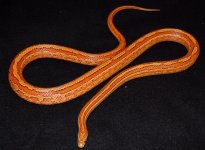I received a message to further explain why a “Het” Tessera is a Tessera. I am looking forward to working with Tessera, but I still have some questions too, so I will explain some of my questions as I go. There is a lot of information already about Tessera on this forum if you do a search.
Tessera is the first obvious dominant pattern gene. I am lucky to have bred Salmon Boas and other Boas with dominant genes, so understanding how it is inherited is easy for me. Boas also have many recessive genes to mix with the dominant ones, so understanding how they mix has already been figured out and I have experience with them.
When we bred Tessera X Normal Pattern, we are actually breeding a Het Tessera X homo Normal, or Tess/N x N/N, The results are 50% Tesseras Tes/N (Het Tess) and 50% Normals N/N. We all want to know if there is a “Super” Tessera. Genetically, I don’t see how homo Tessera , Tes/Tes, will not be produced. It only takes one copy of the Tessera gene to make Tessera because it is dominant, instead of two copies like with recessive genes. Only one parent needs to carry the Tessera gene to make Tessera offspring. With recessive genes, both parents need to carry the gene to reproduce the morph.
Will there be visual differences between homo Tessera and het Tessera, that will give us the Super Morph? In boas, it can be obvious, or like with Salmon Boas, the two phenotypes are very similar and I can not tell them apart.
The questions I still have about Tessera with Motley and/or Striped in the mix, is the possibility of four different phenotypes. Het Tessera, homo Tessera, homo Tessera Motley and homo Tessera Striped. We could add homo Tessera Bloodred to the list. Since Tessera is dominant, testing for Motley will not be the same as testing for Motley like we have done before with Normal Pattern.
It is possible to breed Tessera het Motley X Motley and produce 50% Tessera looking pheno and 50% Motley looking phenos, with no Normals in the clutch. We would be expecting a half a clutch, or quarter to be Normal Phase. We may only get one Normal, or two, but maybe NONE, all of which would be confusing. What about Tessera Motley X Motley, or Tessera Motley X het Motley, if we don‘t already KNOW that the Tessera is in fact homo for Motley. Since we may not know what a Super Tessera looks like visual identification may be difficult.
Since Tessera and Motley phenos look similar, there could be some difficult identifying which is which. (It may be easier than I think, like I said, I have NO experience with Tessera ) Trying to identify Tessera, Tessera Motleys, Tessera Stripes, and possible Super Tesseras VISUALLY, is prone to the same misidentifications as with Striped Bloods. Testing Tesseras to be het or homo for Motley AND Striped will not be as easy as you may think.
Why is MY Tessera unlike the expected described phenotype? Is Aztec the culprit, or how will Borderless change Tesseras pattern, if at all? If recessive genes like Motley and Striped can change Tesseras pattern, then other genes that normally go UNNOTICED can as well. Tessera X Okeetee, Tessera X Aztec and Tessera X Borderless, may have different results. I still have a lot of questions about Tessera phenotypes when matched up to their genetic make up.
Tessera is dominant, that is all that I really care about at the moment and the cause of its popularity. It helps that they look GREAT and the gene is brand spanking new. How Motley, Striped and Diffused effect the Tessera Pattern will be very interesting to learn and prove out, but it is not what makes Tessera special. Tessera is special all by itself.
Mixing Tessera with all of our other Corn Snake genes is going to be the fun part for me and take me half the normal time to see my hard work pay off. For someone just getting into the hobby that wants to breed, Tessera would be my recommendation. I know they are more expensive, but seeing your hard work pay off in two years, and then big in four years, is definitely better than easily DOUBLE the time in the past. Most newer hobbyists just do not have that much dedication yet. With a Tessera, you can reproduce Tessera in two years and with the right secret plan, everybody has the chance to produced a new one of a kind Tessera Morph in four years that nobody else in the entire world has seen before.





